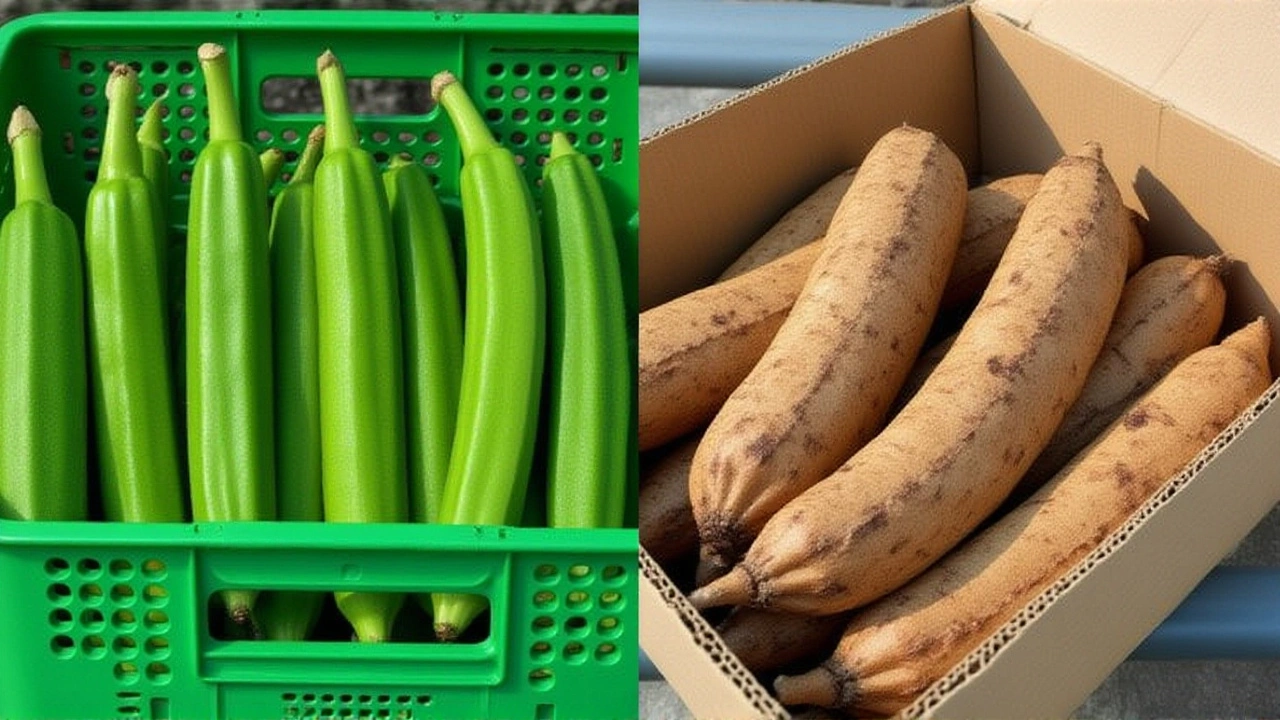
Agromar Fresh is shipping 200 tons of fresh cassava and okra every week from Central America to supermarkets and ethnic grocers across Europe and North America — a quiet but vital lifeline for tropical farmers caught between climate chaos and shifting trade rules. The company, operating on 250 hectares across Costa Rica and Honduras, moved its first container of cassava from Puntarenas to Barcelona just after New Year’s, and by March, it had hit its target: ten full containers weekly, each carrying 20 metric tons of root vegetables. The twist? None of this would be possible without two unexpected policy shifts in late 2025 — one in Washington, the other in Brussels.
Climate Chaos on the Farm
For Daniel Miranda, Agromar’s operations director in Costa Rica, the biggest enemy isn’t competition — it’s the sky. "We used to plant cassava in May and harvest in November. Now, we don’t know if the rains will come in June or August," he told FreshPlaza in January 2025. Unpredictable rainfall has slashed yields by up to 30% in some coastal zones, forcing farmers to delay planting or abandon fields entirely. Costa Rica’s total cassava production in 2019 hit 159,861 tonnes across 10,672 hectares, but the annual growth rate has flatlined at 0.2% since 2020. Meanwhile, the wholesale price swung wildly between $0.47 and $1.10 per pound, making long-term contracts nearly impossible.
But here’s the irony: while domestic demand barely budged, exports kept climbing — until they didn’t. In 2019, Costa Rica exported 113,448 tonnes of cassava, down 15% from 2018. The country ranked 61st globally, contributing less than 1% of world exports. Its top buyers? The United States, Netherlands, Spain, United Kingdom, and Belgium — markets that now demand more than just product. They demand precision.
Washington’s Last-Minute Gift
On November 14, 2025, President Donald Trump signed an executive order that quietly erased tariffs on Costa Rican cassava — along with beef, bananas, coffee, and pineapple juice. The move, announced by Costa Rica’s Ministry of Foreign Trade the next day, reversed a 10% tariff imposed earlier that year under Executive Order 14257. For exporters like Agromar Fresh, it was a lifeline. "We were looking at an extra $12,000 in duties per container," said Miranda. "Now? That’s profit we can reinvest in cold storage or better packaging."
The exemption wasn’t isolated. Similar deals were struck with Argentina, Ecuador, El Salvador, and Guatemala — part of a broader U.S. effort to stabilize supply chains for key tropical commodities. The timing couldn’t have been better. With climate stress squeezing yields, many Costa Rican farms were on the verge of shutting down. The tariff removal gave them breathing room — and renewed confidence from buyers in Texas, New Jersey, and Illinois.

Brussels’ Wax Revolution
But Europe wasn’t offering relief — it was raising the bar. In early 2025, the European Union banned paraffin wax — a petroleum-based coating long used to preserve cassava during its 15- to 18-day sea journey to ports like Algeciras and Rotterdam. The reason? Food safety regulations tightened around synthetic additives. Enter Tropifoods, a family-run Costa Rican exporter since 1990. Their solution? A plant-based wax derived from carnauba and beeswax blends. "It’s more expensive — 40% higher cost per ton — but we have no choice," said manager Luis Guerrero. "If we don’t comply, we lose the entire EU market."
The application process hasn’t changed: wash, dry, dip. The coating takes less than a minute. But the stakes? Everything. Tropifoods’ first shipment using the new wax left Puntarenas in late November 2025. It arrived in Algeciras in early December — intact, shiny, and compliant. "Our customers in Spain and Portugal still recognize our product by the gloss," Guerrero added. "Now they’re asking if we can do the same for malanga and yam."
The EU market, long dominated by Latin American immigrant communities, is now seeing new demand: health-conscious Europeans seeking gluten-free, plant-based staples. Cassava flour, once niche, is popping up in artisanal bakeries in Barcelona and Milan. Agromar Fresh is already testing cassava chips and pre-cooked frozen roots — the next step in their evolution from bulk exporter to value-added brand.
Trade Shows as Battlegrounds
Back in California, at The Global Produce & Floral Show 2025, 20 Costa Rican exporters — including Agromar Fresh — set up booths under the bright lights of the Anaheim Convention Center. Cassava, ginger, fresh pineapple, and tropical flowers lined the tables. Mario Sáenz of PROCOMER, Costa Rica’s export promotion agency, called it "a critical nerve center for North American buyers." Jafet Álvarez C., vice president of a San José-based exporter, said he made five new contacts in three days. "We didn’t just sell product. We sold reliability," he said.
At the same time, in Berlin, Costa Rica’s stand at Fruit Logistica 2025 drew crowds curious about tropical roots. "People asked if cassava could replace potatoes," said one attendee. "We said yes — if we can keep the supply steady."

What’s Next?
Agromar Fresh plans to double its processing line by 2026, moving beyond fresh exports into frozen, dried, and pre-cooked cassava products. The company is also negotiating a joint venture with a Portuguese distributor to handle logistics across southern Europe. Meanwhile, Costa Rica’s Ministry of Agriculture is rolling out drought-resistant cassava varieties funded by a $3.2 million World Bank grant — the first of its kind in Central America.
But the real question isn’t about technology or trade deals. It’s about resilience. Can a small country, battered by erratic weather and complex regulations, turn its agricultural weaknesses into global strengths? Agromar Fresh, Tropifoods, and dozens of other exporters are betting everything on yes.
Frequently Asked Questions
How did the U.S. tariff removal impact Costa Rican cassava exporters?
The November 2025 executive order eliminated a 10% tariff on Costa Rican cassava, saving exporters roughly $12,000 per container. This directly improved profit margins for companies like Agromar Fresh, which had been struggling with climate-driven yield losses. The move also signaled renewed U.S. trust in Central American supply chains, encouraging new contracts with distributors in Texas, Florida, and New York.
Why did the European Union ban paraffin wax on cassava?
The EU banned paraffin wax — a petroleum derivative — under food safety regulations aimed at reducing synthetic additives in consumer products. Though it had been used safely for decades, regulators classified it as non-food-grade. Costa Rican exporters like Tropifoods switched to plant-based alternatives (carnauba and beeswax), even though costs rose 40%. Compliance is now mandatory for any cassava entering EU ports.
What role do immigrant communities play in cassava demand?
Latin American, African, and Arab immigrant populations in Spain, Portugal, the UK, and the U.S. drive 70% of cassava sales in Europe and North America. But demand is expanding: European consumers are increasingly buying cassava as a gluten-free alternative to wheat flour. Sales of cassava-based snacks and flours grew 22% in Germany and France between 2023 and 2025, according to Euromonitor data.
How is climate change affecting cassava production in Costa Rica?
Erratic rainfall has disrupted planting cycles, reducing yields by up to 30% in key regions like the Nicoya Peninsula. Farmers can no longer rely on seasonal patterns, leading to higher costs for irrigation and labor. Between 2019 and 2025, production stagnated despite rising export demand. The government is now testing drought-resistant cassava strains with support from a $3.2 million World Bank grant.
What’s the future of cassava exports from Central America?
The future lies in processing. Companies like Agromar Fresh are shifting from raw root exports to frozen, dried, and pre-cooked products — which command higher prices and longer shelf life. New partnerships with European distributors and investments in cold-chain logistics are underway. By 2027, analysts expect Central American cassava exports to grow 35%, with processed goods making up 40% of total volume.
How does Agromar Fresh’s operation compare to other Central American exporters?
Agromar Fresh stands out for its dual-country model — sourcing cassava from Costa Rica and okra from Honduras — and its owned distribution network in Europe. Most competitors rely on third-party logistics. With 250 hectares under management and ten weekly containers, Agromar is among the top 5 exporters of tropical roots from the region. Its focus on compliance and traceability gives it an edge over smaller farms that struggle with EU or USDA standards.


